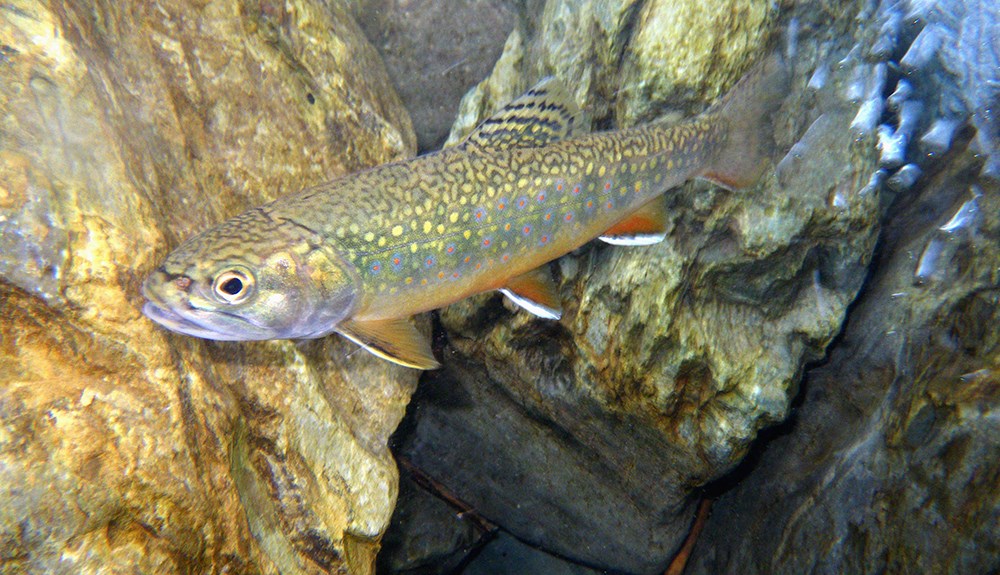Last updated: October 14, 2024
Article
Aquatic Invasive Species Hot Topic
Threats to Glacier

USGS/Joe Giersch
Change is inevitable, as the saying goes. But, is all change good? In the case of invasive species out-competing and threatening the existence of our native plants and animals the answer is simple. No.
The plants and animals in the Crown of the Continent Ecosystem are intertwined. They have adapted to one another for thousands of years, giving each piece to this enormous puzzle a place and a role. Unfortunately, replacing one of these pieces with a non-native species doesn’t keep the picture intact…it creates spaces and gaps, weakening the strength of the entire ecosystem. With each change to our native fisheries and riparian environments comes lasting and sometimes unknown effects. The result is an altered ecosystem, disrupting the delicate balance that keeps this system intact.
Who’s Already Here?
There are six species and one subspecies of non-native fish within Glacier National Park. Some of these non-native species were intentionally introduced to Northwest Montana in the early 1900s by individuals, the Great Northern Railway, and federal and state management agencies all hoping to increase fishing opportunities. The National Park Service was no exception. The stocking of Glacier’s lakes with non-native sport fish began in 1912 and continued until 1972. While this practice included native species such as westslope cutthroat trout, millions of non-native brook, rainbow, and Yellowstone cutthroat trout as well as kokanee were also introduced.
To make matters worse, other introduced species have made their way into park waters presumably from downstream sources. Lake trout, a non-native fish introduced to Flathead Lake in 1905, arrived in many of Glacier’s waters after their population exploded in the 1970s, causing them to seek out new habitat. Today, lake trout dominate most of the park’s western lakes while rainbow and brook trout are found in each of the three major watersheds of the park. As a result, native fish such as the threatened bull and westslope cutthroat trout are forced to compete with these invaders for both food and space.
What’s On the Way?
Unfortunately for resource managers, combating what’s here isn’t the only concern when it comes to aquatic invasive species. It’s what is not here that is even more alarming. Imagine Glacier’s lakes, streams, and wetlands choked by exotic aquatic plants that suck up resources but provide no beneficial food or habitat for wildlife…or Glacier’s waters stripped of essential food and nutrients, the basis of entire food webs, by millions of non-native mussels.
Many of these species loom nearby. Purple loosestrife, a non-native plant found near shorelines already thrives in areas just south of Glacier National Park. Zebra and Quagga mussels are well established in the Mississippi River drainage and are quickly spreading west, causing substantial ecological and economic damage as they go. Listed at right are several invasive species encroaching upon Glacier National Park, why managers are concerned about them, and what you can do to prevent their spread.
Management Strategy
The most imminent threat to Glacier’s waters is the loss of our native fish. For thousands of years, native fish like bull and westslope cutthroat trout have coevolved in this ecosystem. They have survived drought, floods, wildfires, and other episodic events, making them better adapted to the local environment. Presently, of the 17 lakes on Glacier’s west side that support bull trout, lake trout have invaded 9, making it a struggle for bull trout to hold on. Not only does the absence of bull trout present unknown ecological consequences, it also represents a loss to our angling traditions and cultural heritage.
Westslope cutthroat trout is also under siege. Non-native rainbow and brook trout are present in park waters and compete with cutthroat trout for food and habitat. In addition, rainbow and cutthroat trout can interbreed, causing hybrid specimens that have shown reduced growth and survival rates, which ultimately may lead to their demise.
To protect the remaining pure westslope cutthroat and bull trout within the park, Glacier is cooperating with other state and federal agencies to remove nonnative fish where possible. Within Quartz Lake, still a strong-hold for bull trout, researchers with the USGS began netting and removing lake trout in 2009 and are currently evaluating the project’s long-term feasibility. The park is also encouraging visitors to assist in this effort by modifying its fishing regulations, such as removing or increasing catch limits for lake and brook trout.
Education, however, is one of the park’s most valuable tools in the fight against invasive species. Preventing aquatic invasions starts with recognizing the ecological and cultural value of native species and understanding the adverse ecological, social, and economic impacts non-native invaders can have. The more each of us does to stop the spread of aquatic invasive species, the greater chance we have of saving native populations and keeping the balance of Glacier National Park’s fragile ecosystem intact.
Resources for More Information
Glacier National Park Staff
- Chris Downs, Fisheries Biologist
- Dawn LaFleur, Biologist and Exotic Species Manager
Documents and web sites
- Aquatic Invasive Species in Montana http://fwp.mt.gov/fishAndWildlife/habitat/ais
- Northern Rocky Mountain Science Center –https://www.usgs.gov/centers/norock
- Nonindigenous Aquatic Species Information – https://nas.er.usgs.gov
The Crown of the Continent Research Learning Center
Phone: 406-888-5827; Email: melissa_sladek@nps.gov
Website: www.nps.gov/rlc/crown

